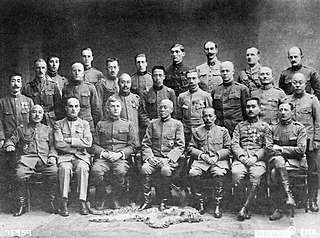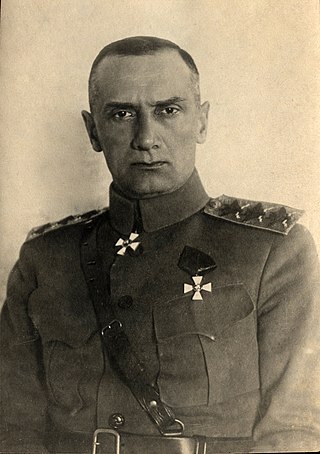
The Trans-Siberian Railway, historically known as the Great Siberian Route and often shortened to Transsib, is a large railway system that connects European Russia to the Russian Far East. Spanning a length of over 9,289 kilometers, it is the longest railway line in the world. It runs from the city of Moscow in the west to the city of Vladivostok in the east.

The Far Eastern Republic, sometimes called the Chita Republic, was a nominally independent state that existed from April 1920 to November 1922 in the easternmost part of the Russian Far East. Although nominally independent, it largely came under the control of the Russian Soviet Federative Socialist Republic (RSFSR), which envisaged it as a buffer state between the RSFSR and the territories occupied by Japan during the Russian Civil War of 1917–1922. Its first president was Alexander Krasnoshchyokov.

The Czechoslovak Legion were volunteer armed forces comprised predominantly of Czechs and Slovaks fighting on the side of the Entente powers during World War I and the White Army during the Russian Civil War until November 1919. Their goal was to win the support of the Allied Powers for the independence of Lands of the Bohemian Crown from the Austrian Empire and of Slovak territories from the Kingdom of Hungary, which were then part of the Austro-Hungarian Empire. With the help of émigré intellectuals and politicians such as the Czech Tomáš Garrigue Masaryk and the Slovak Milan Rastislav Štefánik, they grew into a force over 100,000 strong.

Grigory Mikhaylovich Semyonov, or Semenov, was a Japanese-supported leader of the White movement in Transbaikal and beyond from December 1917 to November 1920, a lieutenant general, and the ataman of Baikal Cossacks (1919). Semyonov was also a prominent figure in the White Terror. U.S. Army intelligence estimated that he was responsible for executing 30,000 people in one year.

Radola Gajda, born as Rudolf Geidl was a Czech military commander and politician.

Polish 5th Siberian Rifle Division was a Polish military unit formed in 1919 in Russia during the aftermath of World War I. The division fought during the Polish-Soviet War, but as it was attached to the White Russian formations, it is considered to have fought more in the Russian Civil War. Its tradition was continued in the Polish Army as the 30th Infantry Division.

The Allied intervention in the Russian Civil War consisted of a series of multi-national military expeditions that began in 1918. The initial impetus behind the interventions was to secure munitions and supply depots from falling into the German Empire's hands, particularly after the Bolsheviks signed the Treaty of Brest-Litovsk, and to rescue the Allied forces that had become trapped within Russia after the 1917 October Revolution. After the Armistice of 11 November 1918, the Allied plan changed to helping the White forces in the Russian Civil War. After the Whites collapsed, the Allies withdrew their forces from Russia by 1925.

The American Expeditionary Force, Siberia was a formation of the United States Army involved in the Russian Civil War in Vladivostok, Russia, after the October Revolution, from 1918 to 1920. The force was part of the larger Allied North Russia intervention. As a result of this expedition, early relations between the United States and the Soviet Union were poor.

The Russian Civil War spread to the east in May 1918, with a series of revolts along the route of the Trans-Siberian Railway, on the part of the Czechoslovak Legion and officers of the Russian Army. Provisional anti-Bolshevik local governments were formed in many parts of Siberia and other eastern regions during that summer. The Red Army mounted a counter-offensive in the autumn of 1918. Throughout the winter and spring of 1918/1919, the White Army had dominance over this front. In the summer of 1919, and from then onwards, the Red Army defeated the White commander Aleksandr Kolchak. The White Army collapsed in the East as well as on other fronts throughout the winter of 1919/1920. Smaller-scale conflicts in the region went on until as late as 1923.

The Siberian intervention or Siberian expedition of 1918–1922 was the dispatch of troops of the Entente powers to the Russian Maritime Provinces as part of a larger effort by the western powers, Japan, and China to support White Russian forces and the Czechoslovak Legion against Soviet Russia and its allies during the Russian Civil War. The Imperial Japanese Army continued to occupy Siberia even after other Allied forces withdrew in 1920.

The Canadian Siberian Expeditionary Force (French: Corps expéditionnaire sibérien) (also referred to as the Canadian Expeditionary Force (Siberia) or simply the C.S.E.F.) was a Canadian military force sent to Vladivostok, Russia, during the Russian Revolution to bolster the allied presence, oppose the Bolshevik Revolution and attempt to keep Russia in the fight against Germany. Composed of 4,192 soldiers and authorized in August 1918, the force returned to Canada between April and June 1919. The force was commanded by Major General James H. Elmsley. During this time, the C.S.E.F. saw little fighting, with fewer than 100 troops proceeding "up country" to Omsk, to serve as administrative staff for 1,500 British troops aiding the anti-Bolshevik White Russian government of Admiral Alexander Kolchak. Most Canadians remained in Vladivostok, undertaking routine drill and policing duties in the volatile port city.
During the Russian Civil War, the Far Eastern part of the former Russian Empire was a battleground for violence between the Russian SFSR and the remnants of the Russian State. The fighting in this front expanded from Outer Mongolia, through Eastern Siberia, and in the Ussuri and Amur districts of Russian Manchuria in Russia.

The Japanese Siberian Intervention of 1918–1922 was a dispatch of Japanese military forces to the Russian Maritime Provinces, as part of a larger effort by western powers and Japan to support White Russian forces against the Bolshevik Red Army during the Russian Civil War. The Japanese suffered 1,399 killed and another 1,717 deaths from disease. Japanese military forces occupied Russian cities and towns in the province of Primorsky Krai from 1918—1922.

The Legione Redenta was an Italian military formation that participated in the Siberian intervention during the Russian Civil War. It was formed from 2500 prisoners of war who had been captured by the Russians from the Austro-Hungarian Army.

The revolt of the Czechoslovak Legion comprised the armed actions of the Czechoslovak Legion in the Russian Civil War against Bolshevik authorities, beginning in May 1918 and persisting through evacuation of the Legion from Siberia to Europe in 1920. The revolt, occurring in Volga, Ural, and Siberia regions along the Trans-Siberian Railway, was a reaction to a threat initiated by the Bolsheviks partly as a consequence of the Treaty of Brest-Litovsk. One major secondary consequence of victories by the Legion over the Bolsheviks was to catalyze anti-Bolshevik activity in Siberia, particularly of the Committee of Members of the Constituent Assembly, and to provide a major boost for the anti-Bolshevik or White forces, likely protracting the Russian Civil War.
The Battle of Barnaul was a series of engagements from 13 June to 15 June 1918, during the Russian Civil War. The battle involved several; different factions in the Siberian region. The Red Guards and White movement were the main combatants.

The Siberian Army was an anti-Bolshevik army during the Russian Civil War, which fought from June 1918 – July 1919 in Siberia – Ural Region.

Alexander Vasilyevich Kolchak was a Russian admiral, military leader and polar explorer who held the title of Supreme Ruler of Russia from 1918 to 1920 during the Russian Civil War, though his actual control over Russian territory was limited. Previously, he served in the Imperial Russian Navy and fought in the Russo-Japanese War and World War I.
The 1st Middle Siberian Corps was one of the main formations of the Siberian Army during the Russian Civil War. It was created on June 12, 1918, under the command of Lieutenant Colonel Anatoly Pepelyayev.

The Russian State was a White Army anti-Bolshevik state proclaimed by the Act of the Ufa State Conference of September 23, 1918, “On the formation of the all-Russian supreme power” in the name of “restoring state unity and independence of Russia” affected by the revolutionary events of 1917, the October Revolution and the signing of the treaty of Brest-Litovsk with Germany.















